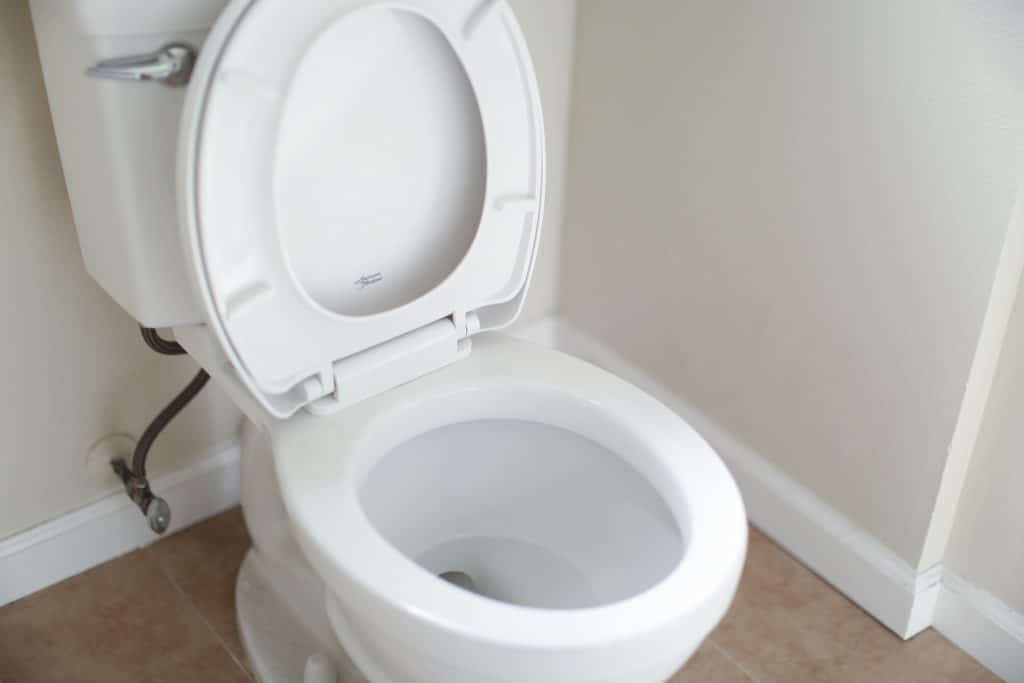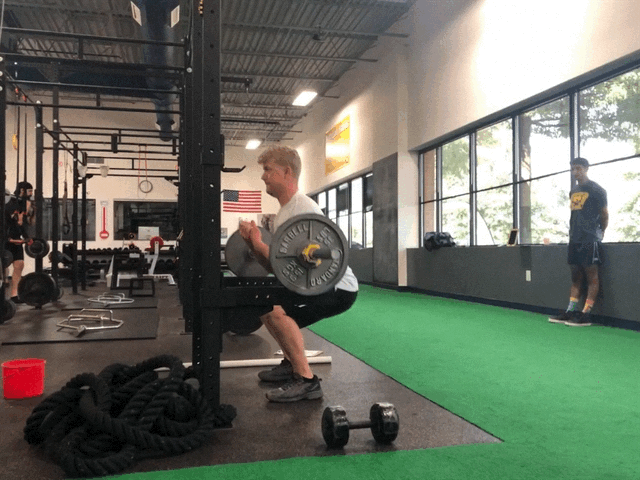Do squats frustrate you? You work and work and work on your form, yet they still feel off. Something just doesn’t click.
If so, it is likely not your fault, because you’ve been misled. You were lied to. Someone told you false information about squatting, which led you to performing a common squat mistake—a myth, really—that has hampered your training. Want to know what that myth is?
It’s this: your knees should never go past your toes when you squat!
For years now, the idea that your knees should not go over your toes when you squat has been taught.
But is it true?
Before I directly answer that, I want you to imagine a scenario.
It’s early in the morning. You’re sipping on your first cup of coffee. And then, you hear the call–nature’s call. It’s time to poop.
So you sit down on your toilet and answer nature’s call; and it goes well, hopefully.
What happens next?
You stand up. Likely, by letting your knees go past your toes.

Now consider this: when your knees went past your toes, did your knees explode? Probably not, or you wouldn’t be reading this because you’d be in surgery.
Similarly, most of us have used stairs before. Guess what happens there? Yup, you guessed it, your knees sometimes go over your toes. And your knees are okay.
Your knees are supposed to be able to go over your toes. That’s normal.
“Hold on a second,” you think. “When I’ve squatted in the past, my knees have hurt when they go past my toes, which is why I stopped doing it.”
While discussing knee pain is out of the scope of this blog, that’s an important thought. It’s an example of correlation not implying causation. Pain is multifactorial. There’s a lot to it. Also, there are plenty of people who squat with knees going past their toes, and they don’t experience pain. There’s more to it than knees going over toes equals pain.
Don’t just take my word for all of this, let’s look at a little research (and don’t worry, I’ll keep it simple).
Restricted And Unrestricted Squats
A study from 2012 had this to say about knees going over the toes in a squat (2):
“Although the maximum moment is higher in the knee for the unrestricted squat compared with the restricted squat, the unrestricted squat generated comparable moments at the same knee flexion angles.”
Uhhh what?
Let’s break that down into non-science speak. They defined two types of squats: restricted and unrestricted.
Restricted squats referred to squats where participants restricted their knees from going past their toes.
Unrestricted squats referred to squats where participants allowed their knees to go past their toes.
So what does the quote above mean? The researchers found a similar “moment”—which, in general, a larger moment means more force on a joint—between similar amounts of knee bend; this assumes good form of course, which the researchers kept an eye on.
Put another way, restricted and unrestricted squats showed similar amounts of force on the knee with the same degree of knee bend. Similar amount of knee bend, similar amount of force.
No knees were harmed in the making of that study.

Then, in a more recent study from 2013, researchers had this to say (1):
“The subject with the greatest anterior knee movement, who showed the highest shear forces, squatted to a knee angle of 90 only. The remaining subjects squatted to 61 and 69 knee angles and possessed lower shear forces.”
What researchers found here was that deep squats—where the knees bent more than 90 degrees—experienced less shear force than stopping at 90. In this study more knee bend actually showed less force on the knee; once again, more knee forward knee travel didn’t cause any issues in the knee to worry about.
One last thing: both studies showed a similar finding with regard to restricting movement of the knees going over the toes, and how it impacts the lower back (1,2). They found that it caused more shear force to be experienced through the lower back.
Put another way, when the knees were allowed to pass the toes, there was less force on the lower back.
Now, this doesn’t mean that this will be bad for the lower back guaranteed, but it’s something to be mindful of. The myth of knees going over the toes—which was started as a way to prevent the knee from experiencing excess stress—actually places our lower back under stress.
So what do we make of all of this?
Let Your Knees Do Knee Stuff
Research to this point shows that, assuming good technique, having your knees pass over your toes when squatting is safe for your knees; and that limiting the knees from passing the toes can put our lower backs under more load.
Look at the video below to see why this is the case.
On the left, I restrict my knees from passing my toes.
On the right, I don’t.
When I actively try to prevent my knees from pushing forward—like our fun squat myth says I should—I have to shift my torso forward (seen on the right side of the video). During this video I felt my lower back go into macho man without trying to (aka arching my lower back). It didn’t feel great.
However, when I allowed my knees to do their thing—to pass over my toes and move naturally—it allowed me to stay upright and keep my tall and tight position.
Make sense? Neato.
So here’s what we do: we let our knees do “knee stuff.” Meaning, assuming there is no pain present—because that’s a whole separate conversation—we should allow the knees to move naturally. If they naturally go over the toes, that’s cool. If they don’t naturally go over the toes, that’s cool too.
One caveat though: we want to keep our whole foot on the floor. One issue with knees going over the toes is that the heels may come off the floor. This decreases stability of the movement as well as decreasing the force we can produce—meaning, it is harder to load the movement safely and effectively with load.
You’re Not Humpty Dumpty
Let’s discuss one more thing: training adaptation 101. In order to get stronger, for our muscle and other tissues to adapt, we must lift progressively heavier loads over time. When we do so, the capacity of our tissues—how much force they can handle—is increased.
Meaning this: training our knees through their normal range of motion, with progressively heavier weights over time, can make them more resilient.
For example, you start out goblet squatting your first day with 25 pounds and, over time, squat 55 pounds. Woo! And, since you’ve been allowing your knees to do knee things and stuff, your knees have become more resilient. They are stronger in positions of deep knee bend.
Now you can stand up after pooping with even more confidence—ready to take on the day!
Because human beings aren’t fragile. You’re not fragile. You’re not Humpty Dumpty, you’re resilient. The myth makes it seem as though your knees will implode the second they go over your toes. Yet, we are designed to move our body in dozens—no, hundreds—of ways.
Since our knees are designed to bend past our toes, and we use this movement in our daily life, then we should train them to be able to handle that.
Let’s do a quick recap:
- Your knees move past your toes on a daily basis and that’s okay.
- When squatting, keep your whole foot on the ground. By having your heel come off the floor, it makes the squat less stable.
- Focus on keeping an even amount of pressure between your big toe, pinky toe, and heel. This enables you to produce more force.
- Your knees won’t explode when they go past your toes during a squat.
By the way, this only scratches the surface of dispelling the myths that are perpetuated in the fitness world; and, more importantly, it only scratches the surface of things that may be preventing you from reaching your fitness goals. If you’re interested in learning more about squatting—and fitness in general—then click below to claim your free week at BSP NOVA.
Sources:
- Hartmann H, Wirth K, Klusemann M. Analysis of the load on the knee joint and vertebral column with changes in squatting depth and weight load. Sports Med. 2013;43(10):993-1008. doi:10.1007/s40279-013-0073-6
- Lorenzetti, Silvio; Gülay, Turgut; Stoop, Mirjam; List, Renate; Gerber, Hans; Schellenberg, Florian; Stüssi, Edgar Comparison of the Angles and Corresponding Moments in the Knee and Hip During Restricted and Unrestricted Squats, Journal of Strength and Conditioning Research: October 2012 – Volume 26 – Issue 10 – p 2829-2836 doi: 10.1519/JSC.0b013e318267918b
